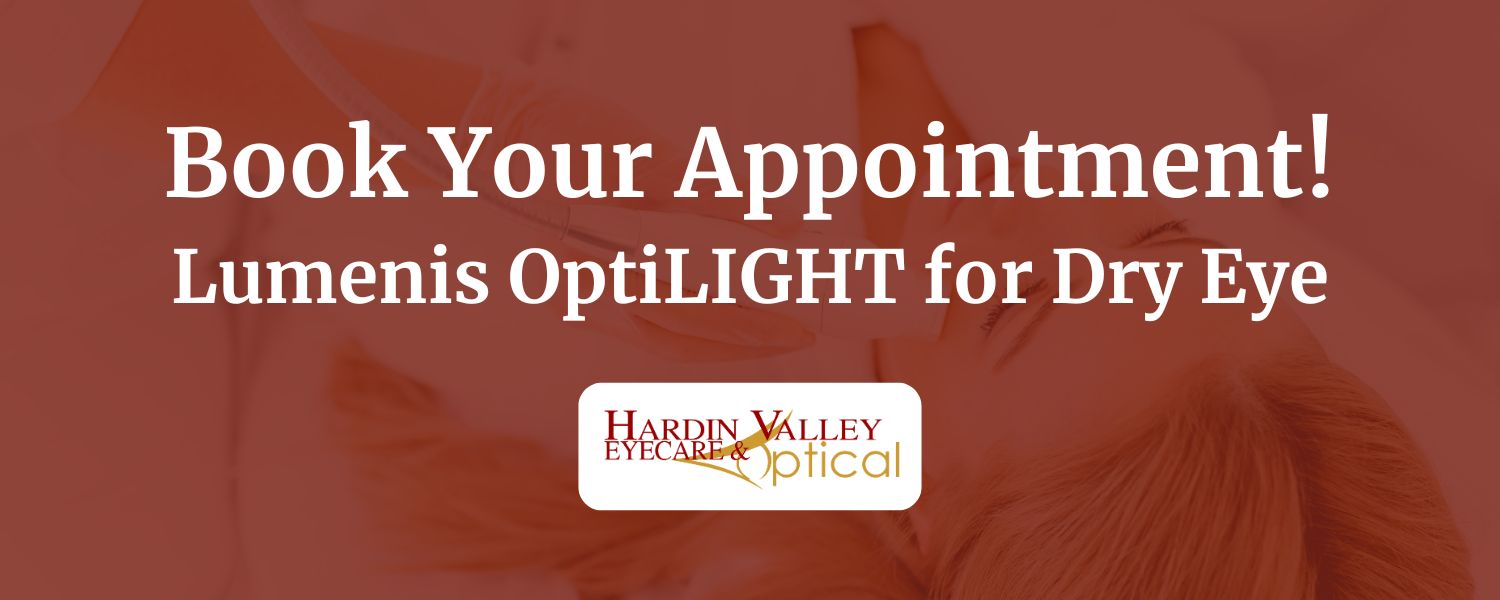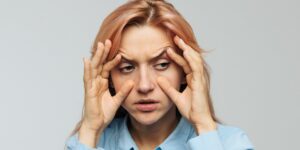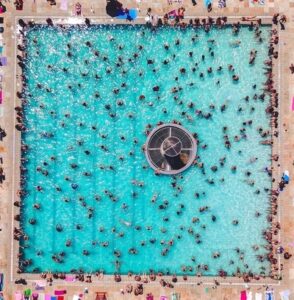Battling dry eyes can be a challenge, but the good news is that various solutions are available to bring relief. In this blog, we’ll delve into the diverse range of treatments tailored to address dry eye symptoms, from artificial tears to specialty eyewear.
Types of dry eye treatment include:
- Lumenis OptiLIGHT
- Artificial tears and lubricating eye drops
- Prescription eye drops
- Anti-inflammatory medications
- The 20-20-20 rule
- Hygiene and lifestyle changes
- Environmental modifications
Types of Dry Eye Treatment in Knoxville, Tennessee
1. Lumenis OptiLIGHT
The Lumenis OptiLIGHT is a pioneering therapy for alleviating dry eye symptoms. Utilizing IPL (intense pulsed light) technology, OptiLIGHT delivers targeted light pulses to the eye area, effectively addressing inflammation and excess tear evaporation. This stimulates natural healing processes, diminishing inflammation and enhancing tear film stability.
Compared to conventional remedies, OptiLIGHT offers enduring relief by tackling the root cause of dry eye without any invasive procedures. Clinical studies affirm its efficacy, with patients reporting reduced dryness and irritation after just a few sessions.
Treatment sessions are non-invasive, targeting blocked glands with gentle light pulses. This can potentially yield improvements in skin health alongside dry eye relief.
Dr. Travis Thompson and Dr. Catherine Abbott play pivotal roles in diagnosing and managing dry eye and providing personalized treatment plans. Offering OptiLIGHT in our practice ensures convenient access to safe and effective therapy, promising improved patient outcomes and enhanced overall experience.
2. Artificial Tears and Lubricating Eye Drops
Artificial tears and lubricating eye drops relieve dry eyes by supplementing the natural tear film, which consists of water, oil, and mucus. These products aim to mimic the composition of natural tears, helping to moisturize and lubricate the eyes.
By enhancing the tear film, they alleviate symptoms such as:
- Dryness
- Irritation
- Discomfort
Regular use of artificial tears keeps the surface of the eyes hydrated and promotes a more stable tear film. Optometrists often recommend preservative-free options for frequent use to minimize potential irritation.
3. Prescription Eye Drops
 In some cases, optometrists may prescribe medicated eye drops. Prescription eye drops for dry eyes work by addressing underlying inflammation in the eye’s surface tissues. This includes prescription eye drops such as cyclosporine (Restasis) or lifitegrast (Xiidra).
In some cases, optometrists may prescribe medicated eye drops. Prescription eye drops for dry eyes work by addressing underlying inflammation in the eye’s surface tissues. This includes prescription eye drops such as cyclosporine (Restasis) or lifitegrast (Xiidra).
In dry eye syndrome, inflammation often disrupts the normal production of tears. These medications correct the immune response, reducing inflammation and promoting a healthier tear film.
By tackling the root cause of dry eyes, prescription eye drops help:
- Enhance tear production
- Improve tear quality
- Alleviate symptoms like burning and discomfort
Optometrists may recommend these medications for moderate to severe dry eye symptoms.
4. Anti-Inflammatory Medications

Anti-inflammatory medications can alleviate dry eyes by targeting and reducing inflammation in the eye’s surface tissues. Inflammation often disrupts the normal production and quality of tears. Anti-inflammatory medications, whether oral or topical, work to suppress this inflammatory response. This helps to restore the balance of tear production and reduce discomfort.
By addressing the underlying inflammatory component, these medications contribute to a more stable and healthier tear film. Optometrists may recommend such medications when dry eye symptoms are associated with significant inflammation. This provides relief and promotes improved ocular surface health.
5. The 20-20-20 Rule
The 20-20-20 rule is a simple strategy to alleviate computer vision syndrome, which affects 66% of people. It involves:
- Taking a 20-second break
- Every 20 minutes
- Focusing on an object 20 feet away
This practice reduces eye strain and encourages regular blinking, preventing the eyes from becoming dry and irritated.
Extended periods of screen time often lead to decreased blinking, causing tears to evaporate more quickly. The 20-20-20 rule interrupts this cycle, promoting natural tear distribution to maintain eye moisture. This approach is a proactive measure that enhances overall eye comfort and reduces symptoms of dry eyes associated with digital device use.
6. Hygiene and Lifestyle Changes
Hygiene and lifestyle changes play a crucial role in managing dry eyes. Good eyelid hygiene involves regular cleaning to remove debris and bacteria. This helps prevent meibomian gland dysfunction, a common contributor to dry eye.
Adequate hydration, a balanced diet rich in omega-3 fatty acids, and staying well-hydrated also contribute to overall eye health. Avoiding smoke and protecting eyes from harsh environmental conditions, like wind and dust, can prevent aggravation of dry eye symptoms.
These changes collectively promote a healthier ocular surface, reduce inflammation, and enhance the production of quality tears. This alleviates the discomfort you experience with dry eyes.
7. Environmental Modifications
Environmental modifications are key in alleviating dry eyes by creating a more supportive atmosphere. Using a humidifier adds moisture to indoor air, preventing excessive evaporation of tears. Shielding eyes from wind, dust, and smoke with wrap-around sunglasses or protective eyewear helps minimize irritants.
Controlling air quality and reducing exposure to allergens contribute to a healthier ocular environment. By optimizing these factors, individuals can mitigate external influences that contribute to dry eye symptoms. This fosters a more comfortable and moisturized ocular surface.
Do you need help with your dry eye symptoms in Knoxville, Tennessee? Contact us today to schedule your appointment!
Lumenis OptiLIGHT offers a pioneering therapy utilizing IPL technology, targeting inflammation and excess tear evaporation to provide lasting relief without invasive procedures. Dry eye treatment options include artificial tears, lubricating eye drops, and prescription eye drops. Anti-inflammatory medications can also be used. Following the 20-20-20 rule mitigates computer vision syndrome. Hygiene, lifestyle changes, and environmental modifications, such as using a humidifier, protect against irritants.
Hardin Valley Eyecare & Optical has been serving Knoxville since 2009. Located at 10904 Spring Bluff Way, you can schedule an appointment online or give us a call at (865) 888-0892.






